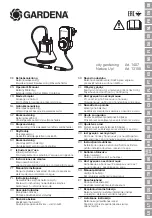
21
The hand-wheel is locked with a plastic lever on which is also marked the main feed scale, 0-10. The interval
between numbers equals a single rotation of the hand-wheel. The outside of the hand-wheel is marked with
10 locking doors, labeled 0-9. Using these allows 100 different adjustment positions to be generated. With
small seed transmission (cassette position II, see Fig. 23) 100 feeding adjustment positions can be generated
in the same way from the smaller rotation number area. The main scale value is read from the inner edge of
the hand-wheel.
Rotating the hand-wheel counter-clockwise increases the feed. When the desired seed sowing amount is
known from the sowing table located inside the machine cover (or from this manual, see Fig. 25), the instructed
feeding adjustment position can then be seen, see Section 11. Note the used power transmission cassette
position, see Figs. 22 and 23.
The hand-wheel should always be adjusted so that the desired adjustment position is always
approached from a greater adjustment position. If the original adjustment position is smaller than
desired, the hand-wheel should be rotated counter-clockwise 1/2-1 times beyond the intended
adjustment, and then rotated backwards to the desired adjustment position.
After this, the adjustment locking lever is inserted into a notch on the hand-wheel, which then locks both the
wheel and lever. Note that the adjustment position given in the seeding table is for reference only - the actual
feed amount will change between different seed batches.
In order to determine actual feed amounts and
obtain an objective value, you should always perform a
calibration or field test, see Sections 12-13
below.
If dirt accumulates on the feeding device or seed characteristics change, i.e. because of the seed dressing
function, the actual feed amount may change significantly from its original value. We recommend cleaning as
needed, but at least on a daily basis. Rollers can be cleaned by adjusting the feed amount to zero and then
again to the desired adjustment value. In such cases the previously stated adjustment rule should be kept in
mind - i.e. rotate first 1/2-1 times beyond the desired adjustment value. The real feed amount can be checked
by repeating the calibration test.
C
AUTION
!
T
HE H
and-wheel must not be forced to a zero-position. Simultaneous rotation of
the feeding axis will ease the adjustment.
C
AUTION
!
the maximum speed when sowing large seeds such as peas and beans is 6-7
km/h. Ensure that the seed tubes do not become blocked. Blockages can cause damage
to the tramline device.
Seed feeding device speed range selection using the power transmission cassette
The rotation speed of JC seed drill seed feeding devices in relation to the driving speed can be selected by
rotating the power transmission cassette. Setting I shown in Fig. 22, where the word ”GRAIN” is on the visible
side, provides a higher rotation speed, which is suitable for sowing normal-sized seeds. Rotating the cassette,
see Fig. 23, achieves 80–90% slower speed II, suitable for small seed sowing.
Figure 22. Power transmission cassette
I = GRAIN.
Figure 23. II = SMALL SEED.
















































